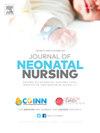沙特阿拉伯新生儿重症监护室护士对袋鼠妈妈护理的认识、实践和障碍
Q2 Nursing
引用次数: 0
摘要
世界卫生组织推荐袋鼠妈妈护理(KMC)作为一种安全且具有成本效益的新生儿干预措施。有限的研究已经进行了评估知识,实践和障碍在沙特阿拉伯新生儿重症监护病房(NICU) KMC。目的评估沙特阿拉伯新生儿重症监护病房护士对KMC的认识、实践和障碍。方法采用横断面相关设计。通过在线调查收集了来自沙特阿拉伯吉达两家医院的97名新生儿重症监护病房护士的数据。该调查涵盖了四个主要领域:人口统计和与工作相关的,关于KMC的知识,KMC的实践以及KMC的障碍。采用独立t检验、单因素方差分析和Pearson积差相关来评估研究变量与KMC实践之间的关系。结果新生儿ICU护士对KMC的认知水平较好(0.74±0.18)。大多数新生儿重症监护室护士报告说,他们的单位(89%)进行过KMC,平均每班1.6次。已婚NICU护士(2.0次,P≤0.05)和接受过KMC培训的NICU护士(1.8次,P≤0.05)上一轮班KMC的平均次数显著高于已婚NICU护士(2.0次,P≤0.05)。家庭的不情愿、对意外拔管和血管通路移位的恐惧、给予家庭的时间不足以及家庭对暴露胸部的不适是KMC的显著障碍(P≤0.05)。结论新生儿ICU护士对KMC有一定的认识。新生儿重症监护室的护士报告了一些进入KMC的障碍。需要制定干预方案来克服这些障碍。需要更多的研究来深入了解沙特阿拉伯的KMC实践和影响它的因素。本文章由计算机程序翻译,如有差异,请以英文原文为准。
Knowledge, practice, and barriers to kangaroo mother care as perceived by neonatal intensive care unit nurses in Saudi Arabia
Introduction
The World Health Organization has recommended kangaroo mother care (KMC) as a safe and cost-effective intervention for neonates. Limited research has been conducted to assess the knowledge, practice, and barriers to KMC in the Neonatal Intensive Care Unit (NICU) in Saudi Arabia.
Aim
To assess the knowledge, practice, and barriers to KMC in the NICU in Saudi Arabia as perceived by NICU nurses.
Methods
This study employed a cross-sectional correlational design. Data was collected from 97 NICU nurses in two hospitals in Jeddah, Saudi Arabia, using an online survey. The survey covered four main domains: demographic and work-related, knowledge about KMC, practice of KMC, and barriers to KMC. Independent t-test, One-way ANOVA, and Pearson Product-Moment Correlation were used to assess the relationship between study variables and KMC practice.
Results
Neonatal ICU nurses possessed a good knowledge level regarding KMC (0.74 ± 0.18). Most NICU nurses reported that KMC was practiced at their units (89%) with a mean of 1.6 times per shift. The mean number of KMC last shift was significantly higher with married NICU nurses (2.0, P ≤ 0.05) and NICU nurses who received training on KMC (1.8, P ≤ 0.05). Significant barriers to KMC were reluctance of the family, fear of accidental extubation and vascular access dislodgement, inadequate time provided to the family, and the family's discomfort with exposing their chest (P ≤ 0.05).
Conclusion
Neonatal ICU nurses had adequate knowledge regarding KMC. The NICU nurses reported some barriers to KMC. Interventional programs are needed to overcome these barriers. More research is needed to gain more insights into KMC practice and the factors that influence it in Saudi Arabia.
求助全文
通过发布文献求助,成功后即可免费获取论文全文。
去求助
来源期刊

Journal of Neonatal Nursing
Nursing-Pediatrics
CiteScore
2.00
自引率
0.00%
发文量
143
期刊介绍:
Aims & Scope: This is the practical, bimonthly, research-based journal for all professionals concerned with the care of neonates and their families, both in hospital and the community. It aims to support the development of the essential practice, management, education and health promotion skills required by these professionals. The JNN will provide a forum for the exchange of ideas and information between the range of professionals working in this field; promote cooperation between these professionals; facilitate partnership care with families; provide information and informed opinion; promote innovation and change in the care of neonates and their families; and provide an education resource for this important rapidly developing field.
 求助内容:
求助内容: 应助结果提醒方式:
应助结果提醒方式:


